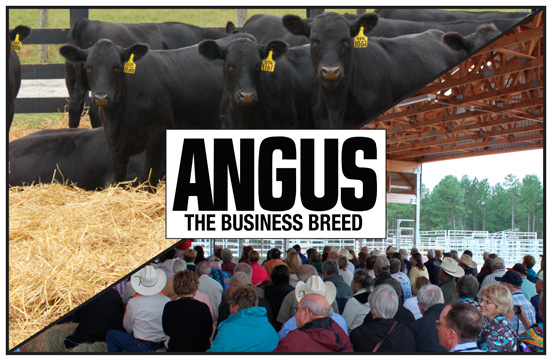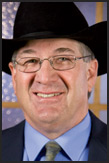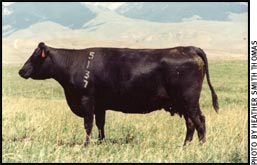
Angus Board Approves
Long-Range Strategic Plan
After more than a century of expansion, the Angus breed has become one of American agriculture's greatest success stories — a story of quality, demand and innovation.
Today, more than 60% of cattlemen identify their herd as Angus, and those Angus-sired calves continue to put more money back into the pockets of cow-calf producers than any other breed — approximately $35 more per head than non-Angus contemporaries according to a recent 10-year study. And thanks to branded beef programs like Certified Angus Beef LLC (CAB), "Angus" has become a household name.
Indeed, the breed is thriving, but Association President Joe Hampton says Angus success won't be taken for granted. Read more.

Vern Frey
Association Perspective
Now is the time to consider vaccinations, marketing opportunities and bull care.
As I write this article, it is mid-October. A lot of you are marketing, have already marketed, or will be marketing your calves. A good time to be giving preconditioning shots is before weaning or selling your calves. These vaccination programs are very valuable to you as commercial producers.
Vaccinations are also valuable to the feeders who are purchasing calves. When calves go to feedyards and stay healthy, the feeders remember and are more likely to purchase or seek out your cattle the next year and for many years afterwards. Read more.
 Freeze-branding
Freeze-branding
Cool tips for applying a better brand.
Freeze-branding was developed at Washington State University (WSU) in 1966, utilizing extremely cold branding irons chilled by liquid nitrogen or a mixture of alcohol and dry ice. Freezing kills pigment-producing cells in hair follicles, and white hairs replace the natural hair color.
James England, University of Idaho, says two key factors for a successful freeze brand are clipping the area (very close to the skin) and pre-wetting the skin with 70% alcohol. Read more.
A Must Read
Proposed regulations could mean big changes for farm youth labor.
An update of federal labor regulations governing youth employment could mean significant changes in the types of work young people can do on the farm, according to the leader of Ohio State University Extension's Agricultural Safety and Health program.
"The Hazardous Occupations Orders For Agricultural Employment hasn't been touched or changed for the past 40 years," said Dee Jepsen, program leader and assistant professor in the Department of Food, Agricultural and Biological Engineering. "What the hazardous occupations order for agriculture does is prohibit youth under the age of 16 from working in and around certain types of environments, outside two basic exemptions." Read more.
Why Do They Value the Land?
California landowners share views on forest and range resources.
Private owners of California's forests and rangelands value their land mostly for its natural amenities and as a financial investment, according to a study published in the October–December 2011 issue of the University of California's California Agriculture journal. About 42% of forest and rangeland is in private ownership.
"A variety of reasons were reported for owning land," reports lead author Shasta Ferranto, a doctoral candidate in UC Berkeley Department of Environmental Science, Policy and Management. Read more.
What’s Inside …
In this October edition of the Angus Beef Bulletin EXTRA, you'll find valuable articles devoted to the management, marketing, and health and nutrition of your beef enterprise. Select from the tabs at the top of the page to access this month's entire offering by category. A few select features include:
- Consider Cover Crops for Fall Grazing:
- Cow Camp Chatter: Short-term cows
- Ridin Herd: Buy supplements right
- Is Your Herd at Risk for Trich?
- Choice-Select Spread Widens
- CAB Sets Records at Year End
- CAB Buys Culinary Center
News Briefs …
The American Angus Association and its subsidiaries generate a wealth of information to keep members and affiliates informed of what's happening within the industry as well as with the programs and services they offer. Click here for easy access to the newsrooms of the American Angus Association and Certified Angus Beef LLC and the Angus e-List archive.
International Partners Improve Cattle Here
and in South Africa
Colleagues collaborate in search of genetic improvement,
disease resistance.
A U.S. Department of Agriculture (USDA) scientist has developed a partnership with colleagues in South Africa that is improving prospects for cattle breeders in that African nation — and could improve them for breeders around the world.
Efforts by Mike MacNeil, an Agricultural Research Service (ARS) geneticist at the agency's Fort Keogh Livestock and Range Research Laboratory in Miles City, Mont., are designed to equip South Africa's scientists with better research tools to help cattle breeders and farmers in remote, underdeveloped areas. Read more.
Protect Your Vision
National Eye Institute urges older Americans to protect their vision with this statement by Director Paul Sieving on World Sight Day 2011, Oct. 13
Older people are at increased risk of several eye diseases, including age-related macular degeneration (AMD), cataracts and glaucoma. AMD can cause profound loss of central vision due to the breakdown of the eye's light-sensing cells in the retina. Cataracts cloud vision through clumping of proteins in the eye's lens. Glaucoma damages the optic nerve often due to increased pressure in the eye. The increase in type 2 diabetes, which is more common in older Americans and especially minorities, means many more are at high risk for diabetic retinopathy, a disease that impairs vision due to diabetes-related injury to the eye's blood vessels.
As a part of the National Institutes of Health, the National Eye Institute (NEI) conducts and supports research of blinding eye diseases, visual disorders, mechanisms of visual function, preservation of sight, and the special health problems and requirements of the blind. Read more.
[Click here to go to the top of the page.]












